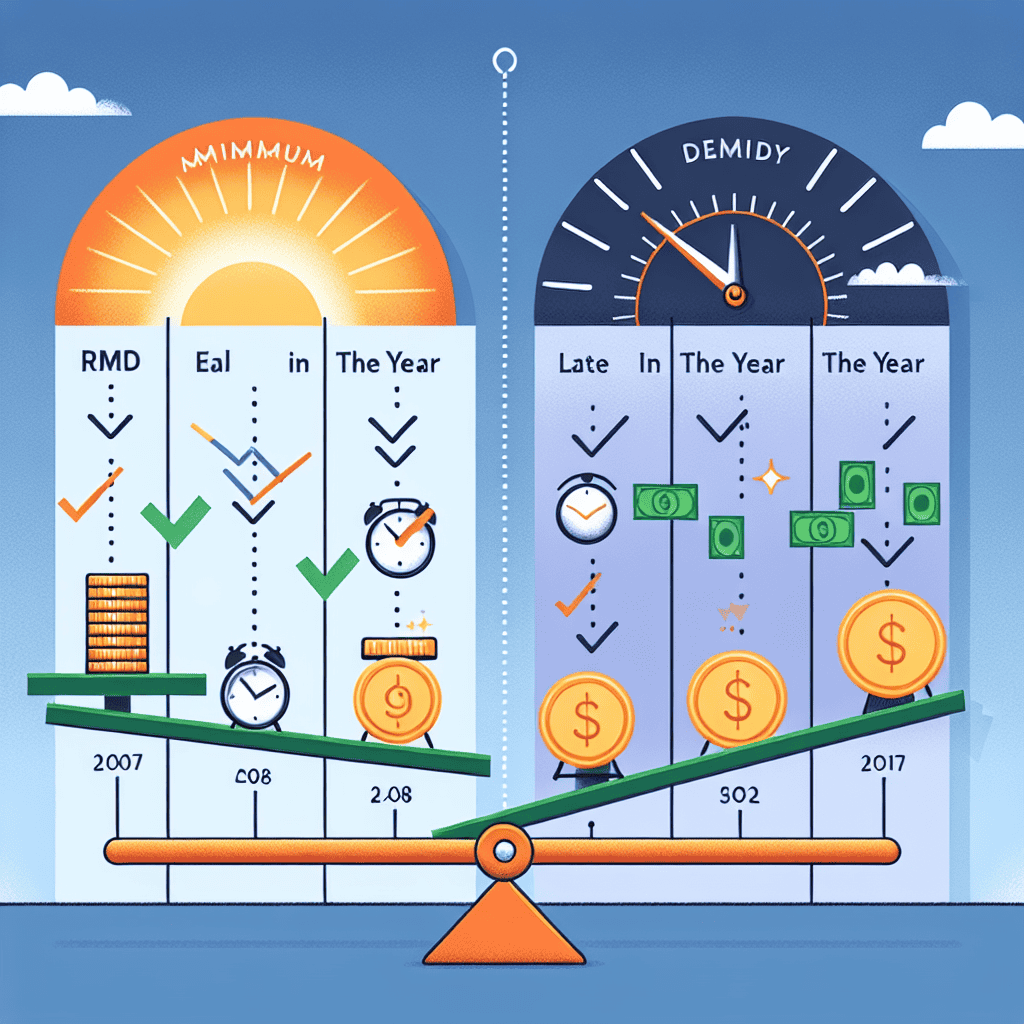“Maximize Your Retirement Strategy: Timing RMD Withdrawals for Optimal Impact.”
Introduction
When it comes to managing retirement accounts, one of the critical considerations for retirees is the timing of Required Minimum Distributions (RMDs). These mandatory withdrawals from traditional IRAs, 401(k)s, and other qualified retirement plans must begin once the account holder reaches a certain age, typically 72, as per the IRS guidelines. The decision of whether to take these distributions early or late in the year can significantly impact financial planning, tax liabilities, and investment growth. Understanding the optimal timing for RMD withdrawals involves evaluating various factors such as market conditions, tax implications, cash flow needs, and potential penalties for non-compliance. By carefully considering these elements, retirees can make informed decisions that align with their financial goals and maximize the benefits of their retirement savings.
Understanding RMD Rules: Early vs. Late Withdrawals
Understanding the optimal timing for Required Minimum Distributions (RMDs) is crucial for retirees who must navigate the complexities of tax regulations while managing their retirement funds. The decision of whether to take RMDs early or late in the year can significantly impact one’s financial strategy, tax liabilities, and investment growth. To make an informed decision, it is essential to consider the rules governing RMDs, the potential benefits and drawbacks of each timing option, and the broader financial implications.
RMDs are mandatory withdrawals that individuals must take from their retirement accounts, such as traditional IRAs and 401(k)s, starting at age 72. The amount is calculated based on the account balance at the end of the previous year and the account holder’s life expectancy. Failing to take the required distribution can result in a hefty penalty, amounting to 50% of the amount that should have been withdrawn. Therefore, understanding the timing of these withdrawals is not only a matter of financial optimization but also compliance.
Taking RMDs early in the year offers several advantages. Primarily, it provides certainty and peace of mind, ensuring that the account holder meets the requirement well before the deadline. This approach can be particularly beneficial for those who prefer to avoid the risk of forgetting or miscalculating the withdrawal amount. Additionally, early withdrawals can be advantageous in a rising interest rate environment, as they allow individuals to reinvest the funds in potentially higher-yielding opportunities sooner. Moreover, for those who rely on RMDs for living expenses, early withdrawals can provide a steady cash flow throughout the year.
Conversely, delaying RMDs until later in the year can also present distinct benefits. By allowing the retirement account to grow tax-deferred for as long as possible, individuals may maximize their investment returns. This strategy can be particularly effective in a strong market, where the potential for growth outweighs the benefits of early withdrawal. Furthermore, delaying RMDs can offer tax planning advantages. By waiting until the end of the year, individuals have a clearer picture of their annual income and can better strategize to minimize their tax burden. This approach can be especially useful for those who anticipate fluctuations in their income or who are managing multiple income streams.
However, both strategies come with potential drawbacks. Early withdrawals may result in missed opportunities for market gains, while late withdrawals carry the risk of market downturns affecting the account balance. Additionally, waiting until the last minute can lead to logistical challenges, such as processing delays or miscalculations, which could result in penalties.
Ultimately, the decision of when to take RMDs should be tailored to an individual’s unique financial situation, risk tolerance, and retirement goals. Consulting with a financial advisor can provide valuable insights and help retirees navigate the complexities of RMD timing. By carefully weighing the pros and cons of early versus late withdrawals, individuals can make informed decisions that align with their broader financial strategy, ensuring compliance with tax regulations while optimizing their retirement income.
Tax Implications of Early vs. Late RMDs
When considering the optimal timing for Required Minimum Distributions (RMDs) from retirement accounts, taxpayers often grapple with the decision of whether to withdraw early or late in the year. This decision carries significant tax implications, which can affect one’s overall financial strategy. Understanding these implications is crucial for retirees who aim to minimize their tax burden while maximizing the benefits of their retirement savings.
To begin with, withdrawing RMDs early in the year provides a sense of financial security and predictability. By taking distributions early, retirees can ensure they meet the IRS requirements without the risk of forgetting or facing penalties for late withdrawals. The penalty for failing to take an RMD is steep, amounting to 50% of the amount that should have been withdrawn. Therefore, early withdrawals can serve as a safeguard against such costly oversights. Moreover, early RMDs allow retirees to plan their cash flow for the year, providing a clearer picture of their available resources for budgeting purposes.
On the other hand, delaying RMDs until later in the year can offer distinct tax advantages. By postponing withdrawals, retirees can potentially benefit from tax-deferred growth for a longer period. This strategy may be particularly advantageous in a rising market, where the value of retirement accounts could increase, thereby enhancing the overall wealth available for distribution. Additionally, delaying RMDs can provide flexibility in tax planning, allowing individuals to strategically time their withdrawals to coincide with lower income years, thereby reducing their taxable income and potentially lowering their tax bracket.
Furthermore, the timing of RMDs can have implications for other aspects of a retiree’s financial situation, such as Medicare premiums and Social Security benefits. For instance, higher taxable income resulting from early RMDs could lead to increased Medicare Part B and Part D premiums, known as Income-Related Monthly Adjustment Amounts (IRMAA). Similarly, the taxation of Social Security benefits is influenced by the retiree’s combined income, which includes RMDs. Therefore, careful consideration of the timing of RMDs can help manage these additional costs.
In addition to these considerations, the choice between early and late RMDs may also be influenced by personal circumstances and financial goals. For some retirees, the peace of mind that comes with early withdrawals outweighs the potential benefits of tax deferral. Others may prioritize maximizing their investment growth and opt to delay distributions. It is essential for individuals to assess their unique financial situation, taking into account factors such as their current and projected income, investment performance, and overall retirement objectives.
Ultimately, the decision of when to take RMDs is not one-size-fits-all. It requires a careful evaluation of the tax implications, market conditions, and personal financial goals. Consulting with a financial advisor or tax professional can provide valuable insights and help retirees make informed decisions that align with their long-term financial plans. By weighing the pros and cons of early versus late RMDs, retirees can optimize their withdrawal strategy, ensuring they meet IRS requirements while minimizing their tax liability and maximizing their retirement savings.
Financial Planning Strategies for RMD Timing
When it comes to Required Minimum Distributions (RMDs), the timing of withdrawals can significantly impact your financial strategy. As individuals reach the age of 73, the IRS mandates that they begin taking RMDs from their retirement accounts, such as traditional IRAs and 401(k)s. The decision of whether to take these distributions early or late in the year is not merely a matter of preference; it involves careful consideration of various financial factors.
To begin with, taking RMDs early in the year can provide a sense of security and peace of mind. By fulfilling the IRS requirement promptly, individuals eliminate the risk of forgetting to take the distribution, which could result in a hefty penalty of 25% of the RMD amount. Moreover, early withdrawals can be advantageous for those who anticipate needing the funds for immediate expenses or who prefer to reinvest the money in a taxable account to potentially benefit from market growth throughout the year.
On the other hand, delaying RMDs until later in the year can offer its own set of benefits. For instance, if the retirement account is invested in assets that are expected to appreciate, postponing the withdrawal allows for potential growth, thereby increasing the overall value of the account. Additionally, waiting until the end of the year can provide more flexibility in tax planning. By assessing one’s total income and tax situation as the year progresses, individuals can make more informed decisions about the timing and amount of their RMDs to potentially minimize their tax liability.
Furthermore, the timing of RMDs can also be influenced by market conditions. In a volatile market, some individuals may choose to delay their withdrawals in hopes of a market rebound, thereby preserving more of their retirement savings. Conversely, in a declining market, taking RMDs early might be a strategic move to avoid withdrawing larger amounts later when account values could be lower.
Another consideration is the impact of RMDs on Social Security benefits and Medicare premiums. Since RMDs are considered taxable income, they can affect the taxation of Social Security benefits and potentially increase Medicare Part B and D premiums. By carefully timing RMDs, individuals may be able to manage their income levels to minimize these impacts.
In addition to these financial considerations, personal circumstances and lifestyle preferences also play a crucial role in determining the optimal timing for RMDs. Some retirees may prefer the predictability of receiving their distributions early in the year, while others might appreciate the flexibility of waiting until later. Ultimately, the decision should align with one’s overall financial goals, risk tolerance, and cash flow needs.
In conclusion, the timing of RMD withdrawals is a multifaceted decision that requires a thorough understanding of one’s financial situation and objectives. Whether choosing to take distributions early or late in the year, it is essential to weigh the potential benefits and drawbacks carefully. Consulting with a financial advisor can provide valuable insights and help tailor a strategy that best suits individual needs. By thoughtfully considering these factors, retirees can optimize their RMD timing to enhance their financial well-being and achieve greater peace of mind.
Impact of Market Conditions on RMD Timing

When considering the optimal timing for Required Minimum Distributions (RMDs), understanding the impact of market conditions is crucial. RMDs, mandated by the IRS for individuals aged 72 and older, require careful planning to minimize tax liabilities and maximize retirement savings. The decision of whether to take RMDs early or late in the year can significantly influence the financial outcome, particularly in the context of fluctuating market conditions.
To begin with, taking RMDs early in the year can offer certain advantages, especially in a rising market. By withdrawing funds early, retirees can potentially avoid the risk of having to sell investments at a lower value later in the year if the market declines. This strategy can be particularly beneficial in a volatile market where predicting future conditions is challenging. Moreover, early withdrawals provide the opportunity to reinvest the funds in other financial instruments that may offer better returns or align more closely with the retiree’s risk tolerance and financial goals.
Conversely, delaying RMDs until later in the year can also be advantageous, particularly in a declining market. By postponing withdrawals, retirees allow their investments more time to recover from any downturns, potentially increasing the value of their portfolio before the RMD is taken. This approach can be especially beneficial if the market is expected to rebound, as it allows for the possibility of withdrawing a smaller percentage of the overall portfolio, thereby preserving more of the retirement savings for future needs.
Furthermore, the timing of RMDs can have significant tax implications. Withdrawing early in the year may result in a higher taxable income, especially if the retiree has other sources of income that are also realized early. This could push the individual into a higher tax bracket, increasing the overall tax burden. On the other hand, delaying RMDs until later in the year allows for more strategic tax planning. Retirees can assess their total income for the year and potentially implement tax-saving strategies, such as charitable contributions or Roth conversions, to mitigate the tax impact of the RMD.
In addition to market conditions and tax considerations, personal financial needs and goals should also influence the timing of RMDs. Some retirees may require the funds early in the year to cover living expenses or unexpected costs, while others may prefer to delay withdrawals to allow their investments to grow. It is essential to balance these personal needs with the potential benefits and risks associated with different market conditions.
Ultimately, the decision of when to take RMDs should be based on a comprehensive evaluation of market trends, tax implications, and individual financial circumstances. Consulting with a financial advisor can provide valuable insights and help retirees develop a strategy that aligns with their long-term financial goals. By carefully considering these factors, retirees can make informed decisions about the timing of their RMDs, optimizing their retirement savings and ensuring financial stability in their later years.
How Early Withdrawals Affect Retirement Cash Flow
When considering the optimal timing for Required Minimum Distributions (RMDs) from retirement accounts, one must carefully evaluate how early withdrawals can impact retirement cash flow. The decision to take RMDs early or late in the year can significantly influence financial stability and tax implications, making it a crucial consideration for retirees. Understanding the nuances of early withdrawals is essential for effective retirement planning.
To begin with, taking RMDs early in the year can provide a sense of financial security by ensuring that the required funds are available to meet living expenses. This approach can be particularly beneficial for retirees who rely heavily on their retirement accounts for day-to-day expenses. By withdrawing early, individuals can avoid the risk of market volatility affecting their account balance later in the year, which could potentially reduce the amount available for withdrawal. Moreover, early withdrawals can help in planning and managing cash flow more effectively, as retirees can allocate funds for specific needs without the pressure of last-minute financial decisions.
However, it is important to consider the potential downsides of early RMD withdrawals. One significant factor is the opportunity cost associated with withdrawing funds earlier than necessary. By taking distributions early, retirees may miss out on potential market gains that could have been realized if the funds remained invested for a longer period. This is particularly relevant in a rising market, where the value of investments could increase, thereby enhancing the overall retirement portfolio. Consequently, individuals must weigh the benefits of immediate cash flow against the potential for future growth.
In addition to market considerations, early RMD withdrawals can also have tax implications. Since RMDs are subject to income tax, taking a large distribution early in the year could push retirees into a higher tax bracket, resulting in a larger tax liability. This is especially pertinent for those with other sources of income, as the additional taxable income from RMDs could exacerbate their tax situation. Therefore, it is advisable for retirees to consult with a tax advisor to understand the potential tax consequences and explore strategies to mitigate them.
Furthermore, early withdrawals can affect eligibility for certain benefits and programs. For instance, higher income levels resulting from early RMDs could impact Medicare premiums or eligibility for other income-based benefits. Retirees should be mindful of these potential repercussions and consider how their withdrawal timing might influence their overall financial picture.
On the other hand, delaying RMDs until later in the year can offer its own set of advantages. By allowing investments to grow for a longer period, retirees may benefit from additional market gains, thereby increasing the overall value of their retirement accounts. This approach can be particularly advantageous in a favorable market environment, where the potential for growth outweighs the risks of volatility.
In conclusion, the decision to take RMDs early or late in the year is a complex one that requires careful consideration of various factors, including cash flow needs, market conditions, tax implications, and eligibility for benefits. Retirees must evaluate their individual circumstances and financial goals to determine the most appropriate timing for their RMD withdrawals. By doing so, they can optimize their retirement cash flow and ensure a more secure financial future.
Late RMDs: Avoiding Penalties and Maximizing Benefits
When it comes to Required Minimum Distributions (RMDs), timing is a crucial factor that can significantly impact both the financial and tax implications for retirees. The decision of whether to take RMDs early or late in the year is not merely a matter of preference but involves strategic considerations that can help avoid penalties and maximize benefits. Understanding the nuances of late RMDs is essential for retirees who wish to optimize their retirement income and minimize potential tax liabilities.
One of the primary reasons retirees might consider delaying their RMDs until later in the year is to maintain flexibility in their financial planning. By postponing the withdrawal, individuals have the opportunity to assess their financial situation more comprehensively. This delay allows them to consider other income sources, unexpected expenses, or changes in tax laws that might influence their overall financial strategy. Moreover, waiting until later in the year can provide a clearer picture of their annual income, enabling more accurate tax planning and potentially reducing the risk of being pushed into a higher tax bracket.
In addition to offering flexibility, delaying RMDs can also be advantageous in terms of investment growth. By keeping funds invested for a longer period, retirees can potentially benefit from additional market gains. This is particularly relevant in a favorable market environment where investments are appreciating. The compounding effect of leaving funds invested can lead to a larger account balance, which, although it may result in a slightly higher RMD the following year, can ultimately enhance the overall value of the retirement portfolio.
However, it is crucial to weigh these benefits against the potential risks associated with late RMDs. One significant risk is the possibility of market volatility. If the market experiences a downturn late in the year, the value of the retirement account could decrease, resulting in a lower RMD amount than anticipated. This could impact the retiree’s cash flow and financial plans. Therefore, it is important for individuals to monitor market conditions and be prepared to adjust their strategy if necessary.
Another critical consideration is the penalty for failing to take RMDs by the December 31 deadline. The IRS imposes a hefty penalty of 50% on the amount that should have been withdrawn but was not. This penalty underscores the importance of careful planning and timely execution of RMDs. Retirees who choose to delay their RMDs must ensure they have a reliable system in place to avoid missing the deadline, such as setting reminders or working closely with a financial advisor.
Furthermore, delaying RMDs can have implications for estate planning. Retirees who wish to leave a larger inheritance to their beneficiaries might prefer to delay withdrawals, allowing the account to grow. However, it is essential to consider the tax implications for heirs, as they may face higher tax rates on inherited accounts. Balancing these considerations requires a comprehensive understanding of both current tax laws and potential future changes.
In conclusion, while delaying RMDs until later in the year can offer several benefits, including financial flexibility and potential investment growth, it also involves certain risks and responsibilities. Retirees must carefully evaluate their individual circumstances, market conditions, and tax implications to make an informed decision. By doing so, they can effectively avoid penalties and maximize the benefits of their retirement savings, ensuring a more secure financial future.
Case Studies: Successful RMD Timing Strategies
In the realm of retirement planning, Required Minimum Distributions (RMDs) play a pivotal role for individuals who have reached the age of 73, as mandated by the IRS. The timing of these withdrawals can significantly impact one’s financial strategy, and understanding the nuances of when to take RMDs—either early or late in the year—can lead to more effective management of retirement funds. Through examining case studies of successful RMD timing strategies, we can glean insights into the benefits and potential drawbacks of each approach.
One case study involves a retiree who opted to take their RMDs early in the year. This individual prioritized financial predictability and stability, choosing to withdraw funds in January. By doing so, they mitigated the risk of market volatility affecting the value of their retirement account later in the year. This strategy proved advantageous during a year when the market experienced a downturn in the latter months. By securing their RMD early, the retiree avoided the potential for a reduced account balance, which could have resulted in a lower withdrawal amount had they waited. Furthermore, this approach allowed for better cash flow management, as the retiree could plan their annual budget with certainty, knowing the exact amount available from their RMD.
Conversely, another retiree chose to delay their RMD until December, capitalizing on the potential for market growth throughout the year. This strategy was particularly successful during a year of market upswings, as the account balance increased, resulting in a larger RMD amount. By waiting until the end of the year, this individual maximized the growth potential of their investments, thereby enhancing their overall financial position. Additionally, delaying the RMD allowed for more flexibility in tax planning. By assessing their total income and tax situation towards the end of the year, the retiree could make informed decisions about other income sources and deductions, potentially minimizing their tax liability.
While both strategies have their merits, it is crucial to consider individual circumstances when determining the optimal timing for RMD withdrawals. Factors such as market conditions, personal cash flow needs, and tax implications should all be weighed carefully. For instance, retirees who rely heavily on their RMD for living expenses may prefer the predictability of an early withdrawal, ensuring they have the necessary funds to cover their costs throughout the year. On the other hand, those with sufficient alternative income sources might benefit from delaying their RMD to take advantage of potential market gains and strategic tax planning.
Moreover, it is essential to remain adaptable and responsive to changing conditions. A retiree who typically withdraws early might consider delaying their RMD in a year with strong market performance, while one who usually waits might opt for an early withdrawal if market forecasts predict a downturn. By staying informed and flexible, retirees can optimize their RMD timing to align with their financial goals and circumstances.
In conclusion, the decision of whether to take RMDs early or late in the year is not a one-size-fits-all proposition. Through careful consideration of individual needs and market conditions, retirees can develop a timing strategy that enhances their financial security and aligns with their broader retirement objectives. By learning from successful case studies and remaining adaptable, individuals can navigate the complexities of RMDs with confidence and foresight.
Q&A
1. **What is an RMD?**
Required Minimum Distribution (RMD) is the minimum amount that must be withdrawn annually from retirement accounts like traditional IRAs and 401(k)s starting at age 72.
2. **Why consider early-year RMD withdrawals?**
Withdrawing early in the year can provide liquidity for expenses and reduce the risk of missing the deadline, which incurs a penalty.
3. **What are the benefits of late-year RMD withdrawals?**
Delaying until later in the year allows the account to potentially grow tax-deferred for a longer period, maximizing investment returns.
4. **How does market performance affect RMD timing?**
If the market is expected to rise, delaying RMDs can be beneficial. Conversely, withdrawing early can be advantageous if a market downturn is anticipated.
5. **What are the tax implications of RMD timing?**
Timing can affect tax planning; withdrawing early might help manage taxable income, while late withdrawals can be coordinated with other tax strategies.
6. **How does life expectancy impact RMD timing?**
Those with longer life expectancies might prefer late withdrawals to maximize tax-deferred growth, while those with shorter expectancies might prioritize liquidity.
7. **What are the penalties for missing the RMD deadline?**
Failing to withdraw the RMD by December 31 results in a 50% excise tax on the amount that should have been withdrawn.
Conclusion
The optimal timing for Required Minimum Distributions (RMDs) from retirement accounts, whether early or late in the year, depends on individual financial circumstances and market conditions. Taking RMDs early in the year can provide liquidity and reduce the risk of market downturns affecting the account balance. However, delaying RMDs until later in the year allows for potentially more tax-deferred growth if the market performs well. Additionally, waiting can provide flexibility in tax planning, especially if income levels fluctuate. Ultimately, the decision should be based on personal financial goals, market outlook, and tax considerations, possibly with guidance from a financial advisor.





